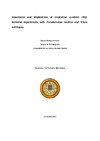Identificador persistente para citar o vincular este elemento:
https://accedacris.ulpgc.es/jspui/handle/10553/11153
| Título: | Importance and implication of respiration Quotient (RQ): a bacterial experimental assay with pseudomonia náutica and Vibrio natrigiensis | Autores/as: | Romero Kutzner, Vanesa | Director/a : | Gómez Cabrera, María Milagrosa Packard, Theodore Train |
Clasificación UNESCO: | 251001 Oceanografía biológica | Fecha de publicación: | 2013 | Proyectos: | Metabolismo planctónico: Regulación Bioquímica e Impacto Oceanográfico sobre la Bomba Biológica | Resumen: | Respiratory metabolism in two different physiological states of acetate and pyruvate grown cultures of Pseudomonas nautica and Vibrio natriegenswere compared. Here we analyze 35 hoursexperiments and 520 hoursexperiments in which time-courses of protein, pyruvate, acetate, respiratory CO2production (RCO2), respiratory O2consumption (RO2), isocitrate dehydrogenase (IDH) activity, and potential respiration were measured. The cultures were monitored through their exponential growth, their steady state, and their senescence phases. Respiratory quotients (RQs) were calculated from the ratio of the respiration rates (RCO2/RO2). Such RQs are widely used in ocean ecosystems models, calculations of carbon flux, and in evaluations of the autotrophic-heterotrophic nature of the ocean, its metabolic balance. In all cultures, regardless of bacterial species and carbon source, the RQ tended to rise nearly an order of magnitude from values below 1 during nutrient sufficiency to values close to 10 during nutrient deficiency. The respiration rates during the growth period paralleled the biomass increase but after the nutrients were exhaustedthe respiration rates fell. Through this same transition period the IDH activity and the potential respiration (φ) remained relatively high for first 10 hours of nutrient deprivation and then fell slowly, along with the biomass, as the nutrient deprivation continued. During this starvation period the biomass specific IDH and φ decreased. This finding challenges the idea that IDH and the respiratory electron transport systems (ETS) are constitutive and can be used for biomass proxies. We conclude that the physiological state of the bacteria affects the RQ. These results argue that many ecosystems models, oceanographic calculations of carbon flux, and evaluations of the ocean’s metabolic balance need to be reconsidered in light of this newly discovered RQ variability. | Departamento: | Biología | Facultad: | Facultad de Ciencias del Mar | Titulación: | Máster Universitario en Oceanografía | URI: | https://accedacris.ulpgc.es/handle/10553/11153 | Derechos: | by-nc-nd |
| Colección: | Trabajo final de máster |
En el caso de que no encuentre el documento puede ser debido a que el centro o las/os autoras/es no autorizan su publicación. Si tiene verdadero interés en el contenido del mismo, puede dirigirse al director/a o directores/as del trabajo cuyos datos encontrará más arriba.
Vista completaLos elementos en ULPGC accedaCRIS están protegidos por derechos de autor con todos los derechos reservados, a menos que se indique lo contrario.
